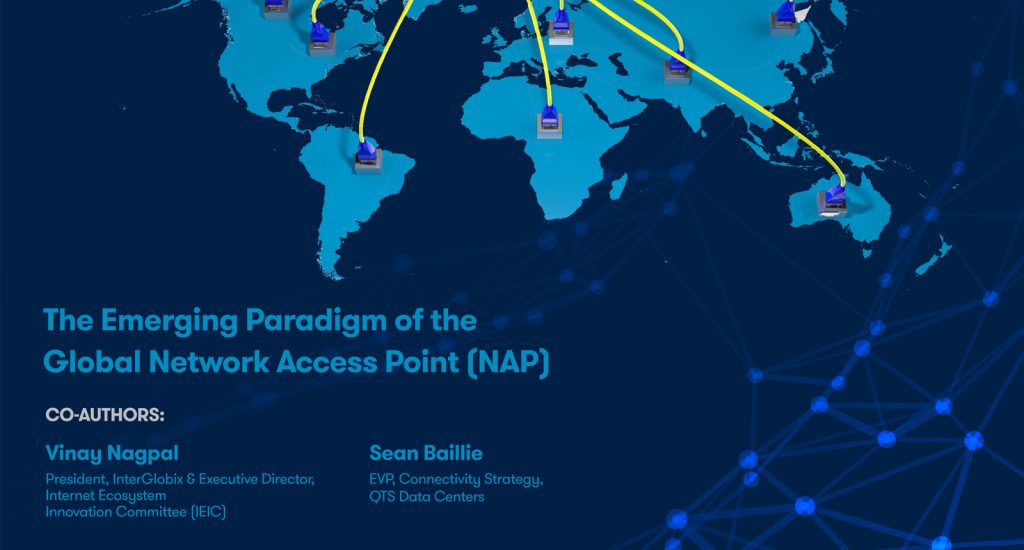
Co-Authored by Vinay Nagpal and Sean Baillie
 Vinay Nagpal
Vinay Nagpal
President, InterGlobix and Executive Director, Internet Ecosystem Innovation Committee (IEIC)
 Sean Baillie
Sean Baillie
Executive Vice President, Connectivity Strategy, QTS Data Centers
TOPICS COVERED
Network Access Point (NAP), Carrier Hotels, Cable Landing Station (CLS), Interconnection Ecosystem, Interconnectivity Hubs
ABSTRACT
As the explosion of data continues to happen around us, the underlying infrastructure plays an ever-increasing pivotal role in moving the data from its source to the destination in a reliable, secure, and latency-sensitive way. In its journey the data (packets) could be traversing various types and numbers of networks including Wi-Fi, small and large cell networks, terrestrial fiber networks, and subsea fiber networks. The various networks interconnect with each other and exchange traffic mainly at a Network Access Point (NAP).
The subsea cables carry above 99.7% of all international data traffic. It is estimated that the subsea cables represent USD 10 trillion worth of transactional value every day — five times the market cap of Apple and greater than the combined GDP of Japan, Germany, and Australia (Source: FCC).
The landing point of the subsea cables is the Cable Landing Station (CLS), which is commonly located near the beach where the subsea cable exits the water. The typical CLS houses the optical terminal equipment (SLTEs), the power feed equipment (PFEs), and provides the initial point of interconnection between the subsea and terrestrial networks. The end-to-end subsea design is driven by the needs of system owners and the availability of modern and diverse terrestrial backhaul facilities. In some cases – particularly hyperscalers – will want to optimize for a data center-to-data center design, while carriers may want to find points of interconnection or NAPs where they have access to a plethora of terrestrial network and content providers.
Multi-tenant data center providers have started to view subsea operators as strategic partners and vice versa. Subsea cables enable global connectivity and have become a catalyst in building network-dense, carrier-neutral NAPs. The subsea industry can realize the inherent benefits in terms of resiliency and redundancies built into the data center design, as well as the rich interconnection to terrestrial networks. Having open and neutral cross connect policies helps make the proposition stronger for various network parties to colocate in a carrier-neutral facility that has clear interconnection rules and facilitates open interconnection between various parties. From a subsea perspective, having the Submarine Line Terminal Equipment (SLTE) in the facility is a cost benefit, but it cannot always be done due to technical design limitations. When the SLTE is colocated in a carrier-neutral, multi-carrier data center with operational excellence, the subsea traffic can be directly interconnected to other network providers including terrestrial fiber providers (both dark and lit), Content Distribution Networks (CDNs), Multiple System Operators (MSOs) or ‘eyeball’ networks, Software-Defined Networks (SDNs), cloud on-ramps, and general co-location customers. QTS Data Centers has taken this strategic approach to establish such interconnection-rich ecosystems or NAPs in Richmond, Virginia; Hillsboro, New Jersey; and Eemshaven, Netherlands.
In this paper, the authors analyze and provide an in-depth look into the key building blocks of a NAP and the current state of the global NAPs including some key paradigm shifts that are happening in this important arena of Internet infrastructure. The paper touches on the critical importance of a CLS in forming a NAP and developing a thriving interconnection ecosystem platform.
Please fill out the form to download the complete white paper.







